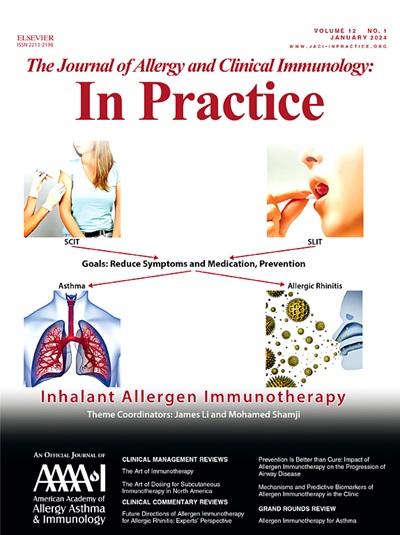特发性过敏反应大查房。
摘要
特发性过敏反应(IA)是指复发性的,危及生命的过敏反应,没有可识别的诱因,代表了诊断和治疗的挑战。我们描述了一个17岁的女孩,表现为反复发作的潮红、瘙痒和呼吸道症状,没有一致的过敏原暴露或辅助因子的参与。评估显示急性胰蛋白酶水平升高,基线正常,皮肤试验阴性,α -半乳糖和KIT突变分析阴性。患者每日服用西替利嗪后病情好转,无进一步反应。IA仍然是一种排除性诊断,需要仔细考虑ige介导的过敏、辅助因子依赖性过敏反应、克隆肥大细胞疾病和全身性模拟,如神经内分泌肿瘤或血管迷走神经性晕厥。我们总结了目前有关IA发病机制、流行病学、鉴别诊断和治疗的证据。虽然抗组胺药和皮质类固醇通常用于预防,但新出现的数据表明,使用omalizumab进行抗ige治疗可能对难治性病例有益。诊断检查应包括血清胰蛋白酶测定、触发因素识别和考虑潜在的肥大细胞疾病。未来的研究需要澄清自然史,标准化诊断途径,并评估这种异质性疾病的长期治疗策略。病例描述:一名17岁的女孩以两小时的潮红、瘙痒和喘息病史就诊于急诊科。这些症状是在晚餐后开始的,晚餐包括牧羊人馅饼和夏威夷坚果,这些食物她以前是耐受的。患者之前没有接触过药物、酒精或昆虫叮咬,在症状出现之前也没有进行过运动。她还报告了另外三次类似的发作。这些症状并不总是与饮食有关,在两次发作之间也没有发现常见的食物或添加剂。无蜱叮咬史。她的反应和月经周期之间没有相关性。患者无特应性(特应性皮炎、过敏性鼻炎、哮喘、ige介导的食物过敏)或过敏史。无自发性或诱导性荨麻疹病史。患者无自发性潮红、瘙痒、腹痛、腹泻、晕厥前或晕厥发作史。她没有骨痛或骨折史。在急诊室进行医学评估时,患者的检查结果是面部红斑和弥漫性荨麻疹。到评估时,呼吸道症状已消失。没有皮肤病变提示皮肤肥大细胞增多症。(图1)除此之外检查无明显变化。给予第二代抗组胺药,数小时后症状逐渐缓解。症状开始后2小时血清胰蛋白酶为17.2 mcg/L。5天后的重复水平为3.2微克/升。在ED出现三个月后的随访中,皮肤点刺试验(SPT)对各种食物和吸入性过敏原(包括夏威夷坚果、小麦和牛肉)呈阴性。血清半乳糖- α -1,3-半乳糖(α -gal) IgE检测为阴性,外周血KIT D816V突变qPCR分析为阴性。患者服用预防性西替利嗪(每日20毫克)3个月,在此期间她没有发生进一步的反应。鉴于临床表现,缺乏可识别的触发因素,以及在ED和5天后获得的胰蛋白酶水平,患者被诊断为特发性过敏反应(IA)。Idiopathic anaphylaxis (IA) refers to recurrent, life-threatening hypersensitivity reactions without identifiable triggers, representing a diagnostic and therapeutic challenge. We describe a 17-year-old girl presenting with recurrent episodes of flushing, pruritus, and respiratory symptoms, without consistent allergen exposure or cofactor involvement. Evaluation revealed elevated acute tryptase levels with a normal baseline, negative skin testing, and negative alpha-gal and KIT mutation analysis. The patient improved on daily cetirizine with no further reactions. IA remains a diagnosis of exclusion, requiring careful consideration of IgE-mediated allergies, cofactor-dependent anaphylaxis, clonal mast cell disorders, and systemic mimics such as neuroendocrine tumors or vasovagal syncope. We summarize current evidence on IA pathogenesis, epidemiology, differential diagnosis, and management. While antihistamines and corticosteroids are commonly used prophylactically, emerging data suggest anti-IgE therapy with omalizumab may offer benefit in refractory cases. Diagnostic workup should include serum tryptase measurement, trigger identification, and consideration of underlying mast cell disorders. Future research is needed to clarify the natural history, standardize diagnostic pathways, and evaluate long-term treatment strategies for this heterogeneous condition. CASE DESCRIPTION: A 17-year-old girl presented to the emergency department (ED) with a two-hour history of flushing, pruritus, and wheezing. The symptoms began after eating dinner, which included shepherd's pie and macadamia nuts, foods she had previously tolerated. There were no preceding exposures to medications, alcohol, or insect stings, and she did not engage in exercise prior to symptom onset. She reported three additional similar episodes. These were not consistently associated with eating, and there were no common foods or additives identified between episodes. There was no history of tick bite. There was no correlation between reactions and stage of her menstrual cycle. She did not have a personal or family history of atopy (atopic dermatitis, allergic rhinitis, asthma, IgE-mediated food allergy) or anaphylaxis. There was no history of spontaneous or inducible urticaria. She did not have a history of spontaneous flushing, pruritus, abdominal pain, diarrhea, presyncopal or syncopal episodes. She did not have a history of bony pain or fractures. At the time of the medical assessment in the ED, the patient's examination was notable for facial erythema and diffuse hives. Respiratory symptoms had resolved by the time of assessment. There were no cutaneous lesions suggestive of cutaneous mastocytosis. (Figure 1) The examination was otherwise unremarkable. She was given 2nd generation antihistamines, and symptoms gradually resolved over several hours. The serum tryptase drawn two hours following symptom initiation was 17.2 mcg/L. A repeat level five days later was 3.2 mcg/L. During a follow up visit three months after ED presentation, skin prick testing (SPT) was negative to a variety of food and inhalant allergens including macadamia nut, wheat and beef. Serum IgE testing to galactose-alpha-1,3-galactose (alpha-gal) was negative, and qPCR analysis for the KIT D816V mutation in peripheral blood was negative. The patient was prescribed prophylactic cetirizine (20 mg daily) for three months, during which she experienced no further reactions. Given the clinical presentation, absence of identifiable triggers and the tryptase levels obtained at the ED and five days later, the patient was diagnosed with idiopathic anaphylaxis (IA).

 求助内容:
求助内容: 应助结果提醒方式:
应助结果提醒方式:


